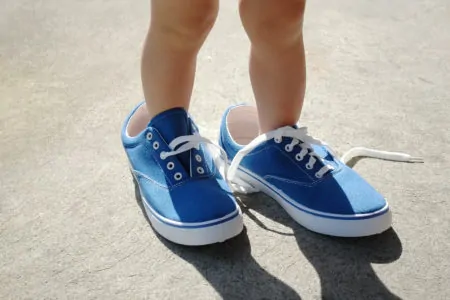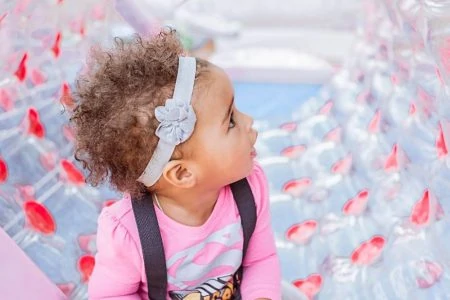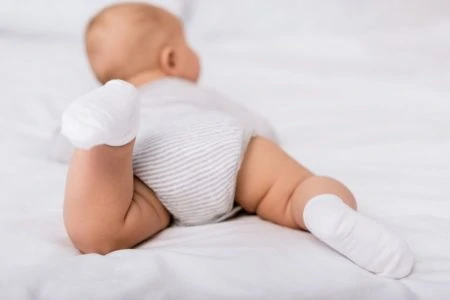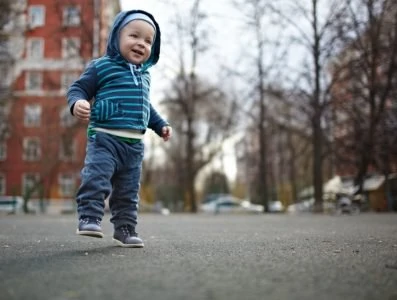Is your little one beginning to walk and it’s time for their first pair of shoes? Or are you looking for footwear for your preschooler, but nothing seems to fit correctly?
Children’s shoes must fit just right — too snug, and you’ll risk problems. Too big, and your kid could trip.
The problem is that kids’ feet grow at what seems like lightning speed. We’ve put together a helpful kids’ shoe size chart for each age group as well as some tips and tricks.
Key Takeaways
- Measure your child’s feet regularly and use a kids’ shoe size chart to find the correct size.
- Choose comfortable, breathable, and supportive shoes for babies, toddlers, and older kids.
- When measuring, consider length, width, and fit; if between sizes, choose the larger size.
- Avoid buying shoes too big to save money, as this can cause discomfort and hinder movement.
Baby Shoe Size Chart (0 to 12 Months)
| U.S. | Euro | UK | Inches | CM |
| 0.5 | 16 | 0 | 3.25 inches | 8.3 centimeters |
| 1 | 16 | 0.5 | 3.5 inches | 8.9 centimeters |
| 1.5 | 17 | 1 | 3.625 inches | 9.2 centimeters |
| 2 | 17 | 1 | 3.75 inches | 9.5 centimeters |
| 2.5 | 18 | 1.5 | 4 inches | 10.2 centimeters |
| 3 | 18 | 2 | 4.125 inches | 10.5 centimeters |
| 3.5 | 19 | 2.5 | 4.25 inches | 10.8 centimeters |
| 4 | 19 | 3 | 4.5 inches | 11.4 centimeters |
| 4.5 | 20 | 3.5 | 3.625 inches | 11.7 centimeters |
| 5 | 20 | 4 | 4.75 inches | 12.1 centimeters |
Toddler Shoe Size Chart (One to Five Years)
| U.S. | Euro | UK | Inches | CM |
| 5.5 | 21 | 4.5 | 5 inches | 12.7 centimeters |
| 6 | 22 | 5 | 5.125 inches | 13 centimeters |
| 6.5 | 22 | 5.5 | 5.25 inches | 13.3 centimeters |
| 7 | 23 | 6 | 5.5 inches | 14 centimeters |
| 7.5 | 23 | 6.5 | 5.625 inches | 14.3 centimeters |
| 8 | 24 | 7 | 5.75 inches | 14.6 centimeters |
| 8.5 | 25 | 7.5 | 6 inches | 15.2 centimeters |
| 9 | 25 | 8 | 6.125 inches | 15.6 centimeters |
| 9.5 | 26 | 8.5 | 6.25 inches | 15.9 centimeters |
| 10 | 27 | 9 | 6.5 inches | 16.5 centimeters |
| 10.5 | 27 | 9.5 | 6.625 inches | 16.8 centimeters |
| 11 | 28 | 10 | 6.75 inches | 17.1 centimeters |
| 11.5 | 29 | 10.5 | 7 inches | 17.8 centimeters |
| 12 | 30 | 11 | 7.125 inches | 18.1 centimeters |
Kids Shoe Size Chart (Six to Ten Years)
| U.S. | Euro | UK | Inches | CM |
| 12.5 | 30 | 11.5 | 7.25 inches | 18.4 centimeters |
| 13 | 31 | 12 | 7.5 inches | 19.1 centimeters |
| 13.5 | 31 | 12.5 | 7.625 inches | 19.4 centimeters |
| 1 | 32 | 13 | 7.75 inches | 19.7 centimeters |
| 1.5 | 33 | 14 | 8 inches | 20.3 centimeters |
| 2 | 33 | 1 | 8.125 inches | 20.6 centimeters |
| 2.5 | 34 | 1.5 | 8.25 inches | 21 centimeters |
| 3 | 34 | 2 | 8.5 inches | 21.6 centimeters |
| 3.5 | 35 | 2.5 | 8.625 inches | 21.9 centimeters |
| 4 | 36 | 3 | 8.75 inches | 22.2 centimeters |
| 4.5 | 36 | 3.5 | 9 inches | 22.9 centimeters |
| 5 | 37 | 4 | 9.125 inches | 23.2 centimeters |
| 5.5 | 37 | 4.5 | 9.25 inches | 23.5 centimeters |
| 6 | 38 | 5 | 9.5 inches | 24.1 centimeters |
| 6.5 | 38 | 5.5 | 9.625 inches | 24.4 centimeters |
| 7 | 39 | 6 | 9.75 inches | 24.8 centimeters |
How to Measure Kids Feet
Measuring your kid’s feet is pretty straightforward, and there are a few ways to do it. When in doubt, you can always get a second measurement from a professional in a children’s shoe shop. If you want to DIY it, here are three easy methods:
1. Tracing
Tracing is the most common way to measure children’s feet at home — it’s easy, and not much equipment is required. Here’s what you need:
- A blank paper.
- A marker.
- Ribbon.
- Ruler.
- One pair of bare feet.
Remember Both Feet
Here’s what you do:
- Trace the feet: Stand your child on a piece of paper on top of a clipboard or on a hard, non-carpeted floor. Try to get them to stand against a wall with their back straight. Use the marker and trace the outline of the feet — keep the marker at an upright angle for the best results.
- Measure the length: Have your child step away from the paper. Measure the length from the heel to the tallest point on the big toe. Write the results down and mark them as length.
- Measure the width: Grab the ribbon and wrap it around the broadest part of your child’s foot (the ball). Mark where the end of the ribbon touches. Measure the length from the end of the ribbon to the mark, and you’ve got the width.
- Find the size: Once you’ve got your measurements, use your guide to find the appropriate size.
2. Printable Guide
Most shoe brands and manufacturers include a size guide — many even provide you with a handy printable one. These are useful and can help you find the perfect fit. You can have a look at your favorite brand’s website — we love the one from StrideRite.
Here’s what you’ll need:
- A printable guide (this is the one we used).
- Scissors.
- Tape.
- A wall.
- Pencil.
- Credit card.
- Shoelace.
- Your kid.
Here’s the breakdown on what you do:
- Prepare the print: After you’ve printed the guide, use the scissors to cut along the dotted lines — cut the length and width rulers. Then grab the tape and fasten the length ruler to the floor — try to align the curved line with the wall. The idea is that the heel will be against the wall.
- Measure the length: Place your kid’s foot on the length ruler, with the heel up against the wall, aligned with the curved line. Then use a marker to label the first line after the big toe — write the length in the space provided. Remember to use the correct column for the right or left foot.
- Measure the width: While your child is standing up straight, use the width ruler, and slide it under the foot. Wrap it closely around the widest part and mark where the ruler meets the “align here” indicator. Take note of the results.
- Try a shoelace: A shoelace also works to measure the width. Wrap it around the widest part, and then mark where the end touches the lace. Remove it, and measure the distance between the mark and the end that went around the foot.
3. Use a Shoe Size Gauge
Using a size gauge is another simple method of measuring your kid’s shoe size. They’re available to buy online and at some shoe retailers.
Here’s what you need:
- Measuring device.
- Paper.
- Pencil.
- Feet.
And here’s what you do:
- Stand up straight: Ask your child to stand up with their back straight, facing forward.
- Place the foot: Have a look at your measuring device and locate where the heel should be. Then place the right heel in position.
- Note the results: Write down the numbers facing you, and you should have the correct length.
- Measure the width: Some shoe measuring devices have a bar that you slide over your child’s foot to measure the width. Consult the instructions. If not, you can use the ribbon or shoelace techniques mentioned in the two methods above.
How Often to Size Your Kid’s Feet
Tiny tootsies grow fast — between the ages two and six, their feet can grow up to half a size every two to four months. Experts recommend that up until four years, you make a shoe change every two to three months. To ensure the size is correct, look to measure their feet every two months (1).
After their fourth birthday, foot growth does slow down a bit, and they may not need a shoe change that often. Experts recommend every four to six months. However, continue sizing their feet at least every three to four months.
When Your Child Is Between Sizes
Not all feet are similar — sometimes two feet on the same child can grow differently. If your child is between sizes, it’s always recommended to go with the larger foot.
Having a shoe that’s a size too big is better. Using footwear that’s too small could lead to issues such as foot deformities or ingrown toenails (2).
Shoe Buying Tips
1. Shoe Shopping Tips for Babies
Before your baby begins to walk, you don’t need shoes. During this time, baby shoes such as booties, soft-soled, and socks are best. Once your little one starts to take their first steps, it’s time for a supportive shoe (3).
Don't Rush
- Go for breathable and lightweight: For a new walker, comfort is crucial. Look for something made of cloth or soft faux leather.
- Soft soles: When looking at the shoes, try to bend the soles. If they flex easily, they will provide good support for your new walker. If not, leave them on the shelf.
- Shop in the afternoon: Baby feet tend to swell later in the day. So to ensure the shoe fits perfectly, do your shopping in the afternoon.
- Verify the fit: Try to place your pinky finger in between your baby’s heel and the back of the shoe while they stand. If it feels tight, the shoe is probably too small.
2. Shoe Shopping Tips for Toddlers
- Bring socks: Unless you’re shopping for sandals, your tot will likely have to wear socks with shoes. Use the appropriate socks — thick for winter boots and light for summer sneakers. Then the shoe will fit right even when there’s extra padding.
- Forget trends: Don’t give in to the latest trends of clogs, pointy boots, or high heels. These aren’t likely to provide any beneficial support to a toddler who’s still mastering their walk. Instead, go for something supportive.
- Provide options: Some toddlers want to decide what they wear. If so, find a few different, but appropriate, shoes and ask your little one to choose which they like best.
- Opt for Velcro: A hook and loop closure such as Velcro is much easier for a toddler to put on without assistance. This way, your child learns how to put on shoes, and you save time otherwise wasted tying shoelaces.
3. Shoe Shopping Tips for Older Kids
- Let them move: Once your child is wearing both shoes, let them do a strut around the shop. Watch how they walk and see if the shoe provides support, or looks uncomfortable. Then ask your child how they feel — be specific — ask if they feel tight or too loose.
- Thumbs up: While your child is wearing the shoes, try to fit your thumb between the heel and the back of the shoe — you want it snug but not tight, so you avoid blisters. Then use your thumb to press at the front — feel for the big toe and how far forward it sits. There should be a thumb’s width between the toe and the end of the shoe.
- Don’t think too big: If you’re on a budget, It can be tempting to buy a shoe that’s a few sizes too big. This isn’t ideal — at this age, your child is active and needs a supportive shoe that won’t come off unexpectedly.
No More Toe Jam
Finding a correctly fitting shoe size for your child is essential. Footwear that’s too small can lead to long-term side effects, and too large will hinder them from walking or playing correctly. Using a kids’ shoe size chart is a great way to get an idea of which size to go for.
Measure your child’s feet regularly, depending on their age. It’s easy to do at home by tracing, using a printable guide, or purchasing a size gauge.






